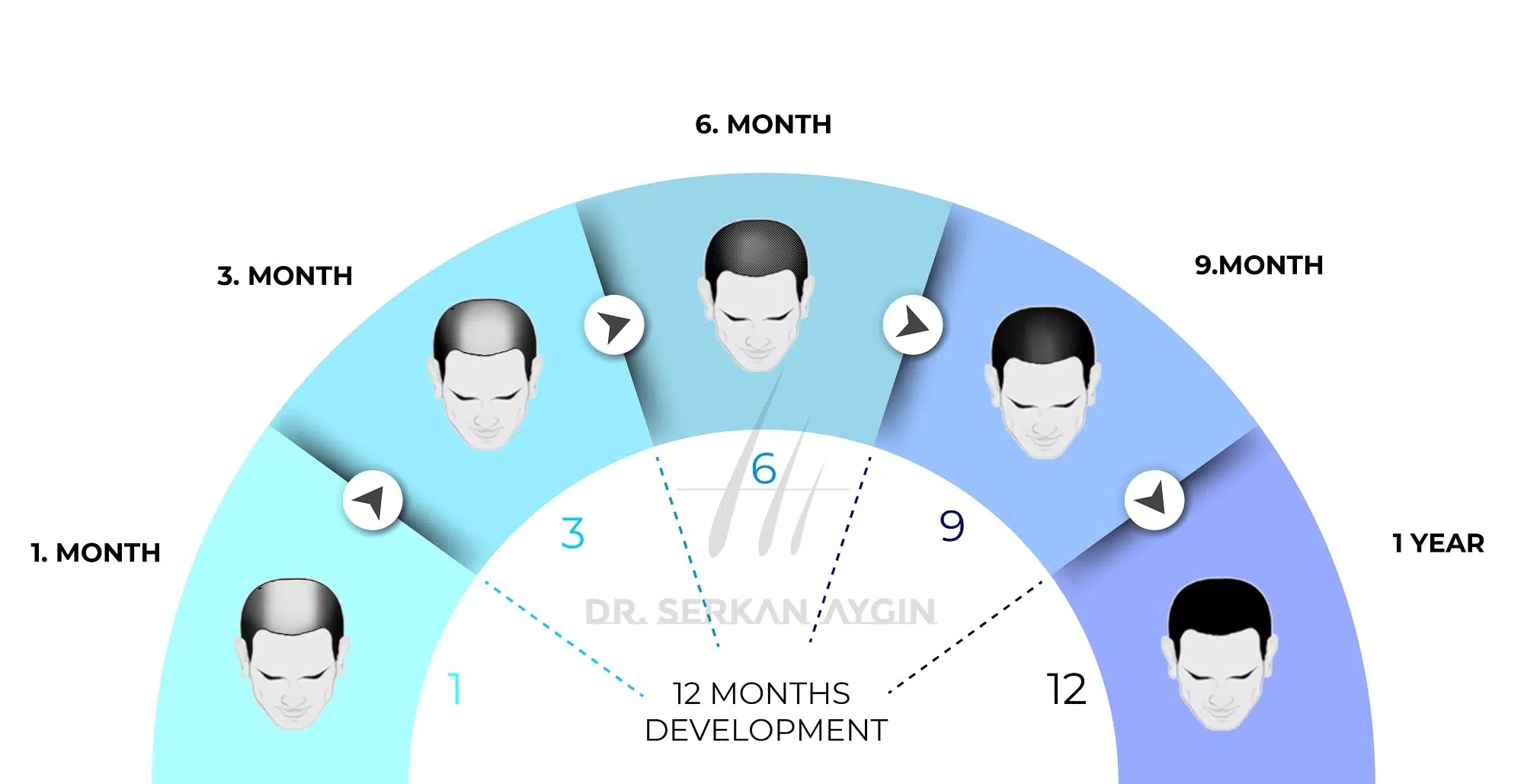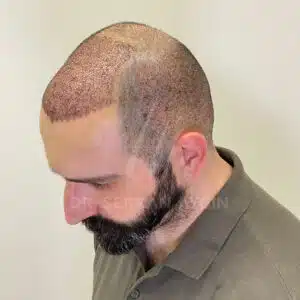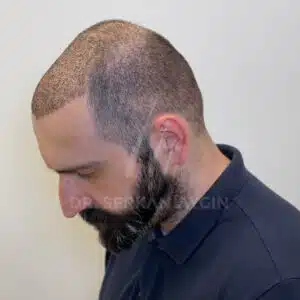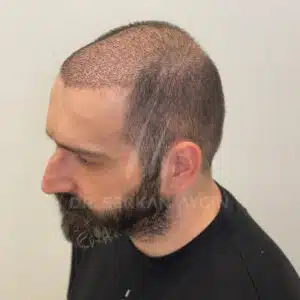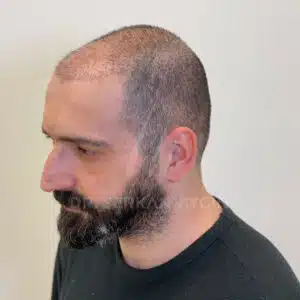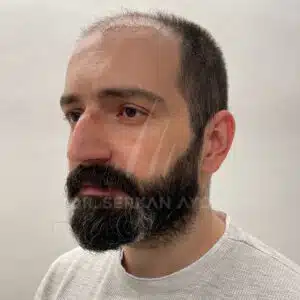Hair transplant timeline refers to the progression of hair growth after the surgery. It’s the post-operation part where you will see changes in the following days or months. The healing process looks different for every patient, but there are symptoms and improvements everyone encounters at similar times.
A hair transplant is a long but rewarding journey. In this FUE hair transplant timeline, you will find what will happen immediately post-op, after 7 days, a month, and even a decade after hair transplantation.
We will explain what awaits a patient including scars, shock loss, hair growth, and more. You can find the notable points the article will mention here:
- LEARNING ABOUT THE HAIR GROWTH CYCLE IS KEY IN ANTICIPATING THE CHANGES IN HAIR FOLLICLES AFTER HAIR TRANSPLANT.
- TRANSPLANTED HAIR TAKES AT LEAST 3-4 WEEKS TO START GROWING, BUT THE FINAL RESULTS ARE SEEN AFTER 12 MONTHS.
- WHILE RECOVERY PERIOD MAY VARY DEPENDING ON THE PATIENT, USUALLY THE FIRST YEAR AFTER HAIR TRANSPLANT LOOKS THE SAME FOR THE MOST FUE SURGERIES.
- AFTERCARE INSTRUCTIONS MUST BE FOLLOWED DILIGENTLY TO PROMOTE SMOOTHER HEALING AND REDUCE ADVERSE EFFECTS.
- HAIR TRANSPLANT PROVIDES LONG-TERM SUCCESS BUT PATIENTS SHOULD MAINTAIN THEIR HAIR HEALTH ROUTINE.
Let’s jump right in and learn what to expect after a hair transplant!
Post Hair Transplant Stages: Hair Growth Timeline
To understand the hair growth after a hair transplant, first, we need to understand the hair growth cycle. Natural hair goes through three phases:
- ANAGEN PHASE: HAIR SHAFTS GROW DURING THE ANAGEN PHASE, WHICH LASTS FROM 2-8 YEARS. USUALLY, 85%-90% OF YOUR HAIR AT ANY GIVEN TIME IS IN THE ANAGEN PHASE.
- CATAGEN PHASE: HAIR FOLLICLES START GETTING SMALLER AND THE BULB OF THE HAIR FOLLICLE DETACHES FROM THE SCALP DURING THE CATAGEN PHASE, WHICH TAKES ABOUT 2-4 WEEKS.
- TELOGEN PHASE: HAIR ROOTS REST DURING THE TELOGEN PHASE, LASTING ABOUT 3-4 MONTHS. IN THE TELOGEN PHASE, NEW HAIR BEGINS TO DEVELOP AT THE BASE OF THE HAIR FOLLICLE AND EVENTUALLY PUSHES OUT THE OLD HAIR. AT THE END OF THE TELOGEN PHASE, THE OLD HAIR SHEDS, AND THE NEW ONE COMES OUT.
The cycle of hair follicles is affected by several factors, and a hair transplant procedure is one of them.
Here, our hair tansplant postop timeline chart and pictures.
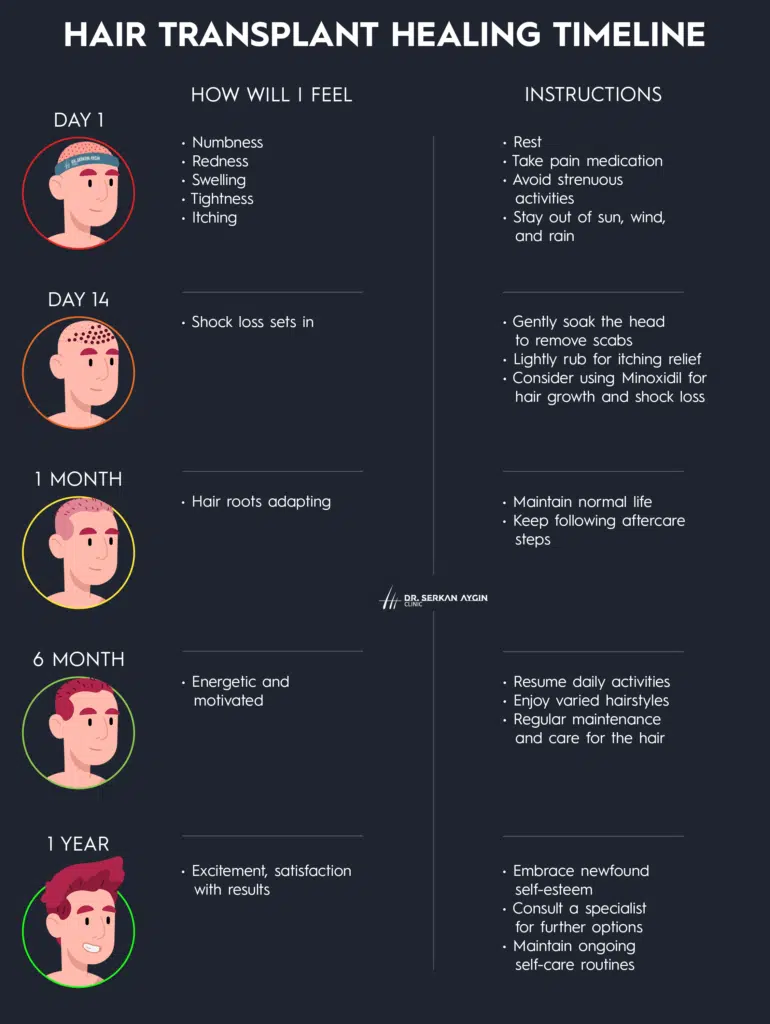
When Does A Hair Transplant Start To Grow?
Transplanted hair usually grows 3-4 weeks after hair transplant surgery. Before then, the scalp is busy with repairing hair transplant scabs. The hair on the donor area starts growing immediately.
How long until hair grows after hair transplant depends on several factors:
- ACTIVE HORMONES SUCH AS DHT (DIHYDROTESTOSTERONE)
- INFLAMMATION
- DIET & NUTRITION
- BLOOD FLOW
The hair transplant results timeline depends on how diligently the patients follow aftercare instructions. As long as you take proper care of your new head of hair, your recovery process will go smoothly.
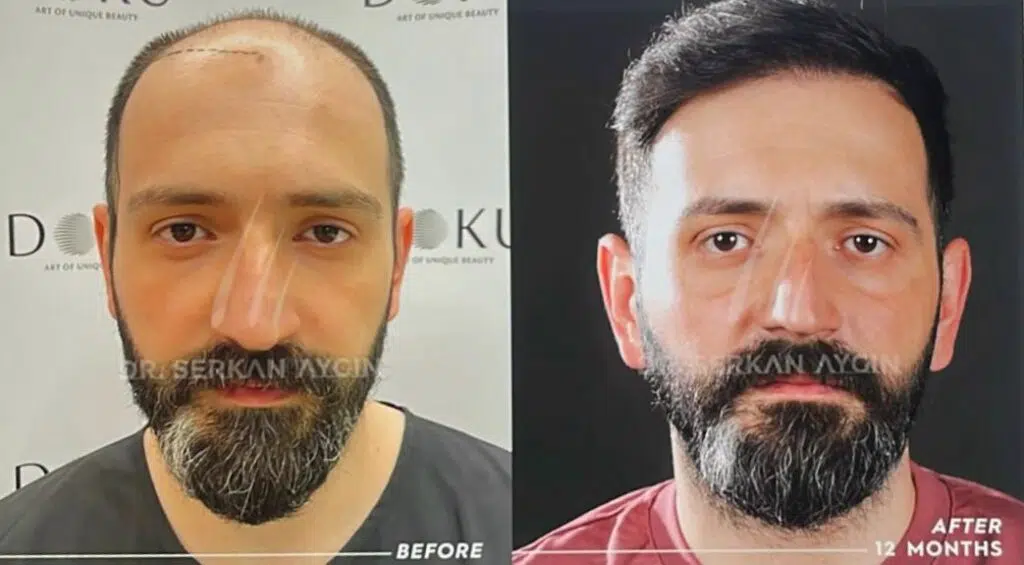
Click on the pictures to view them detailly.
What To Expect In Early Days After Hair Transplant (Day 1 To 3 Weeks)
The hair growth rate and hair density may differ depending on the patient’s condition, the aftercare, and the hair transplant operation.
The majority of hair transplant operations are done by the FUE technique so we will follow the FUE hair transplant timeline as well. Keep in mind that while the recovery period for FUE and DHI are basically the same, the hair transplant stages of FUT may diverge from our timeline.
Let’s examine them one by one!
Day 1 Post-Op Hair Transplant
HOW WILL YOU FEEL?
As the local anesthetic wears off your crown area, where your hair grafts are, you might experience these symptoms:
- REDNESS
- SWELLING
- SCABBING
- TIGHTNESS
- TINGLING OR BURNING
- ITCHING
HOW WILL YOU LOOK?
You will have bandages over the donor area. Hair grafts might make your scalp look bumpy aka the infamous hair transplant dots. Your crown area, where your hair grafts are, might look red and swollen.
There might be small amounts of bleeding on the bandages, which is normal.
WHAT SHOULD YOU DO?
Rest! Post-op day 1 of hair transplant should be spent getting used to this new sensation on your head.
- TAKE PAINKILLERS IF NEEDED
- SLEEP UPRIGHT IN POSITIONS
- AVOID ALCOHOL OR TOBACCO PRODUCTS
- DO NOT TOUCH YOUR HAIR GRAFTS
- SPRAY YOUR SCALP WITH SALINE SOLUTION
- STOP ANY STRENUOUS EXERCISE
- STAY AWAY FROM THE SUN, WIND AND RAIN
WHAT TO EXPECT IN THE FOLLOWING DAYS?
Some of the side effects will slowly go away, such as scabs and redness, but itching and aching might continue. The donor area hair will start growing.
7 Days After Hair Transplant
You have completed your first week after a hair transplant. The post-surgery period is nearly over.
HOW WILL YOU FEEL?
A more comfortable week awaits as your scabs will start falling away and redness will subside. The wounds from hair grafts will heal greatly but itching and aching might continue as scars close up.
HOW WILL YOU LOOK?
The hair in the donor area isn’t affected by shock loss or harvesting, so you will start seeing hair regrowth along the donor area. You will have less redness and swelling in your crown area. There might be scabs but you will be free of any open scars.
WHAT SHOULD YOU DO?
You can start wearing hats after hair restoration surgery to protect your hair from environmental elements.
- SLEEP UPRIGHT POSITIONS
- AVOID ALCOHOL OR TOBACCO PRODUCTS
- DO NOT TOUCH YOUR HAIR GRAFTS
- SPRAY YOUR SCALP WITH SALINE SOLUTION
- STOP ANY STRENUOUS PHYSICAL ACTIVITY
- STAY AWAY FROM THE SUN, WIND AND RAIN
WHAT TO EXPECT IN THE FOLLOWING DAYS?
10 days after hair transplant, the hair on your donor area will have spread to your scalp. Your hair grafts will start settling into your scalp. The shock loss (telogen effluvium) might set in as your hair follicles start a new cycle in their new homes.
❗ 5-7 days after hair transplant you can start washing your hair on your own as instructed by your hair transplant clinic.
14 Days After Hair Transplant
HOW WILL YOU FEEL?
The two weeks after the hair transplant mark can be a mentally difficult time for some patients due to the onset of shock loss (telogen effluvium). Don’t fret! It’s only your hair roots settling and adapting to your scalp.
⭐We’re sure you will feel energized despite shock loss since you can start your regular physical activities.
HOW WILL YOU LOOK?
You will start to see glimpses of your new head of hair! Scars, scabs, swelling, and itching should be mostly gone. Shock loss might cause patchy bald spots to appear on your scalp but they are temporary.
WHAT SHOULD YOU DO?
If prescribed, you can start using Minoxidil after hair restoration to enhance hair growth and combat shock loss.
WHAT TO EXPECT IN THE FOLLOWING DAYS?
🧑 Shock loss will gradually calm down.
👨⚕️ You will have your second check-up, our hair specialists will evaluate your progress and provide extra information if needed.
1 Month After Hair Transplant
HOW WILL YOU FEEL?
All other side effects such as burning, itching, scars, and scabs are nonexistent at this point. Redness may persist until 6 weeks after hair transplant.
HOW WILL YOU LOOK?
The native hairs and transplanted hairs might be at different lengths. But your hairline will be more noticeable now and you will have a rough idea of how your appearance will develop further down the line.
WHAT SHOULD YOU DO?
If there are any scabs left, you can gently soak your head in lukewarm water to wash away the scabs. For those wondering when can I rub my head after a hair transplant, this is the time! You can lightly rub or gently tap with your fingers if you experience itching.
WHAT TO EXPECT IN THE FOLLOWING DAYS?
Shock loss will slowly subside throughout the next month. You will start to see baby hairs growing on the crown area.
Hair Transplant Post-Op Monthly Progress (2 Months To 9 Months)
Hair transplant monthly progress is the timeframe where the results are slowly coming in. The initial hardships of surgery are behind you. This period might seem longer in perspective but keep in mind that the results of these 10 months will keep on for the next 10 years.
2 Month After Hair Transplant
2 months after the hair transplant, aftercare instructions start to feel repetitive and results seem minimal compared to the effort.
You can push through! The worst is behind and only blue skies (or should we say luscious hair) ahead.
HOW WILL YOU FEEL?
Shock loss may persist in some cases but we assure you that it’s a normal part of the recovery process. Your hair density after a hair transplant won’t be affected by the hair you shed during shock loss.
HOW WILL YOU LOOK?
You will have 0.5-1.5 inches (1-3 cm) of hair growth. You will start to appear more presentable by this point.
Some hairs might be thinner, lighter in color. These are called vellus hairs. Vellus hairs are hairs that haven’t reached maturity yet.
WHAT SHOULD YOU DO?
Contact your hair clinic if you’re experiencing:
- BURNING
- ITCHING
- SCARS
- BLEEDING
WHAT TO EXPECT IN THE FOLLOWING DAYS?
12 weeks after hair transplant you can start swimming, going to the sauna, wearing motorcycle helmets, and more.
The hair transplant 3 months post-op is a mark that everyone waits eagerly for because you can finally start enjoying different activities.
Hair Transplant After 4 Months
The fun times are ringing the doorbell. You are cleared to swim, go to the sauna, wear motorcycle helmets, and more! 4 months after a hair transplant is when you first start to notice the results and the future feels brighter.
HOW WILL YOU FEEL?
We presume you will feel awesome as you’re cleared from now on to swim to your heart’s content or enjoy a relaxing day at the sauna.
HOW WILL YOU LOOK?
You might still see vellus hairs among your newly growing hair. Hair growth might still be patchy but it’s going to become more uniform.
WHAT SHOULD YOU DO?
You should still take care of your hair follicles by covering your head while swimming, avoiding diving or water sports, and putting on sunscreen.
You can ask your hair specialist about any supplementary treatments such as minoxidil, finasteride, PRP, or LLT if you want faster results.
WHAT TO EXPECT IN THE FOLLOWING DAYS?
Vellus hairs will slowly mature, and bald patches will be covered completely. Your hair will grow evenly and dense.
Hair Transplant 6 Months Later
You have successfully passed the difficult hair transplant stage! Make sure to pull out a mirror because the real transformation is happening.
HOW WILL YOU FEEL?
Most patients are back to their normal routines with relatively grown hair at this point. Having more options for styling your hair allows for the satisfaction after a hair transplant to set in.
HOW WILL YOU LOOK?
You will have a growth spurt:
- SCALP HAIR WILL BECOME LONGER
- CROWN AREA WILL BECOME DENSER
- NEW HAIRS WILL BECOME THICKER
WHAT SHOULD YOU DO?
You can continue your daily life as you see fit.
You can now comb, brush, cut, trim, and style your hair in any way you want! Hair transplant results after 6 months remind people why they went on this journey in the first place.
WHAT TO EXPECT IN THE FOLLOWING DAYS?
This is the home stretch! Enjoy your new strands and keep practicing good hair health.
And the good news is, this is not the final form of your head. Your hair follicles will keep maturing until one year after hair transplant.
Hair Transplant Result After 12 Months
Congratulations! The journey has come to an end. At this point, you should have an idea of how you will look in the foreseeable future.
HOW WILL YOU FEEL?
Hopefully, amazing! You’re free of even traces of scarring and you have luscious hair.
HOW WILL YOU LOOK?
At this stage, most patients conclude that they’ve achieved what they dreamed of. Both donor and recipient areas are covered in lush hair and fully recovered. Your hair will continue to grow at 1-3 cm per month.
WHAT SHOULD YOU DO?
12 months after hair transplant is the finish line of your hair transplant journey. What do you need moving forward?
- CONTINUE YOUR LIFE WITH A NEWFOUND SELF-ESTEEM
- CONSULT YOUR HAIR SPECIALIST ABOUT FURTHER OPTIONS
Below, one of our happy patients is talking about his hair transplant journey:
FUE Hair Transplant Healing Timeline
FUE hair transplant recovery is a short and comfortable period that patients go through while their scalp heals from surgery and hair grafts settle.
- The three months after the FUE hair transplant can be described as a time of healing. Initially, the scars, scabs, and wounds will regenerate and then, hair follicles will go through shock loss to adapt to their new homes.
- The remaining nine months after FUE hair transplant is a time of growth, for the hair! Most patients start to notice the outcome of their hair restoration surgery during the last 9 months after hair transplant.
Modern methods such as Sapphire FUE provide an even shorter and more comfortable healing period as well.
DHI Hair Transplant Healing Timeline
DHI recovery is even shorter than FUE recovery due to the techniques that DHI utilizes.
- The use of the Choi pen allows for a fast and precise surgery
- Direct implantation ensures healthier hair grafts
- No incisions means way less scarring
- Bleeding and trauma are minimized
The rapid healing provided by DHI vs. the traditional FUE is a dilemma that many patients experience.
FUT Hair Transplant Healing Timeline
FUT hair transplant has the longest recovery period out of all techniques of hair transplantation. The FUT technique requires a strip of skin to be cut from the donor area of the scalp. Many patients are left with the infamous FUT strip scar after hair restoration surgery.
HOW DOES HAIR TRANSPLANT RECOVERY DIFFER FOR DIFFERENT PROCEDURES, SUCH AS FUE AND FUT?
FUE and FUT have completely different methods to harvest and implant hair grafts.
In FUE, hair grafts are plucked one by one from the donor area of the scalp and as soon as harvesting is finished, hair grafts are implemented to the recipient area. Thanks to one-by-one harvesting, FUE causes minimal scarring and heals very quickly.
Meanwhile in FUT, a strip of skin is removed from the donor area, and hair grafts are separated. Then, hair grafts are transplanted into the recipient area. As you can imagine, removing a linear strip of skin can leave a noticeable scar, which is why some individuals prefer alternative hair transplant methods such as direct hair implantations.
Hair Transplant Scar Healing Time
Hair transplant scar healing time changes depending on the technique of hair transplant. FUT (Follicular Unit Transplantation) scars take longer to heal due to removing a strip of skin from the back of the head.
On the other hand, DHI and FUE scars look like red dots on the scalp because small channels are opened to insert the follicular grafts.
Beyond the First Decade (10 Years and Beyond)
Hair transplant is a permanent solution to hair loss, meaning that your transplanted hairs will not be subject to MPHL (Male Pattern Hair Loss) or FPHL (Female Pattern Hair Loss). Even 10 years after hair transplant surgery, patients get to boast a full head of hair. There are a few catches:
- Transplanted hair follicles go through the same aging cycle as native hair follicles. They will also become grayer and thinner with age. It’s up to the patient’s overall health and genetics.
- Any disease that affects the blood supply to the scalp will compromise transplanted hair follicles as well. Going through chemotherapy, autoimmune diseases, or alopecia areata may cause transplanted hairs to fall.
Long-term Results and Maintenance
💊 Use finasteride or minoxidil to promote hair growth
💉 Support your hair with treatments like PRP and LLL
🥗 Follow a healthy diet and exercise routine
🧴 Choose hair products that aren’t harsh on the scalp
👨⚕️ Consider a second hair transplant if necessary
Can you wear a hat after a hair transplant?
Yes, 14 days after hair transplant you can start wearing hats to prevent damage to your hair follicles. You should choose hats that suit the criteria below:
- LIGHTWEIGHT
- MADE OF BREATHABLE MATERIAL
- LOOSE ON THE HEAD
- NOT WORN LONGER THAN 4 HOURS
What if I'm Unhappy with My Hair Transplant?
If you’re unhappy with the hair regrowth, consult your hair specialist regarding other hair restoration treatments such as PRP, LLL, minoxidil, or finasteride for further support. | If you feel like the amount of hair grafts hasn’t covered the areas affected with hair loss, wait until you reach the one-year after hair transplant mark and consult your hair specialist about a hair transplant revision. |
When Can I Return to Normal Life After A Hair Transplant?
You can return to normal life immediately after a hair transplant. We recommend our patients to rest and recuperate for the first few days. Additionally, there will be aftercare instructions you need to follow for a few weeks after hair transplant. We’re listing some examples of aftercare here:
- AVOID STRENUOUS EXERCISE FOR 2 WEEKS
- AVOID SUN, WIND AND RAIN FOR 1 MONTH
- AVOID ALCOHOL AND TOBACCO PRODUCTS FOR 1 MONTH
- WASH YOUR HAIR AS INSTRUCTED BY YOUR HAIR SPECIALIST
As long as you take proper care of your hair follicles, you can continue your daily life right away. Check out our aftercare article to find out what you can do to preserve your hair follicles.
Can I Pray After A Hair Transplant?
Yes, starting from your surgery day, it is allowed to pray salah. You need to make sure to pray while sitting for a few days to protect your head from coming into contact with the prayer rug and avoid dizziness and infection.
Praying whilst sitting down helps you avoid bending over and rushing the bloodstream to your head which is crucial for your recovery. Even if you are not light-headed or feel pain around your surgery area, you still need to be cautious because of the local anesthesia you received. You can make your own rules around how to pray after a hair transplant if you prioritize your recovery and adapt your prayer routine accordingly.
References:
[1] Natarelli N, Gahoonia N, Sivamani RK. Integrative and Mechanistic Approach to the Hair Growth Cycle and Hair Loss. J Clin Med. 2023 Jan 23;12(3):893. doi: 10.3390/jcm12030893. PMID: 36769541; PMCID: PMC9917549.
[2] Hughes EC, Saleh D. Telogen Effluvium. 2023 May 29. In: StatPearls [Internet]. Treasure Island (FL): StatPearls Publishing; 2023 Jan–. PMID: 28613598.
[3] Van Neste, D.J.J. and Rushton, D.H. (2016), Gender differences in scalp hair growth rates are maintained but reduced in pattern hair loss compared to controls. Skin Res Technol, 22: 363-369. https://doi.org/10.1111/srt.12274
[4] Cash, T. F. (2009). Attitudes, behaviors, and expectations of men seeking medical treatment for male pattern hair loss: results of a multinational survey. Current Medical Research and Opinion, 25(7), 1811–1820. doi:10.1185/03007990903005201

